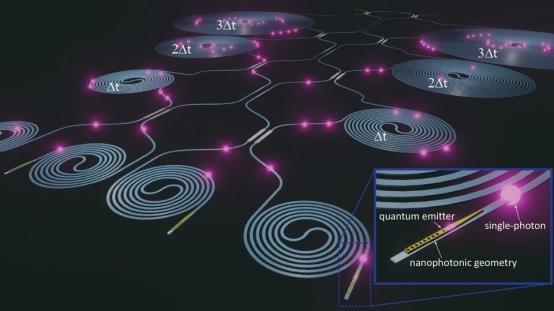NIST develops ultra-low-loss integrated photonic circuits for quantum computing applications
Recently, researchers at the National Institute of Standards and Technology (NIST) and their colleagues have connected a quantum dot single-photon source (a quantum dot is an artificial atom that produces individual photons quickly and on demand when irradiated by a laser) to a microcircuit capable of directing light without significant intensity loss on a microchip.

Future versions of the new photonic circuit will use low-loss waveguides (channels through which single photons pass) up to 3 meters long, but tightly coiled around the chip. The long waveguide will allow researchers to more precisely select the time interval (Δt) at which photons leave different channels to rendezvous at a particular location.
Integrated photonic circuits could be used in quantum computers
The ability to transmit and manipulate the smallest unit of light photons with minimal loss plays a key role in the design of optical communications as well as quantum computers, which will use light rather than charge to store and carry information.
To create ultra-low-loss circuits, the researchers made silicon nitride waveguides: channels through which photons pass, and buried them in silicon dioxide. These channels are wide but shallow, a geometry that reduces the likelihood of photons scattering out of the waveguide. Encapsulating the waveguide in silica also helps reduce scattering. The scientists report that the intensity loss of their prototype circuit is only one percent of that of similar circuits built by other teams.
Ultimately, devices using this new chip technology can take advantage of the strange properties of quantum mechanics to perform complex calculations that may not be possible with classical (non-quantum) circuits. How exactly is this achieved?
According to the laws of quantum mechanics, a photon has the probability of staying in two different places at the same time, such as two different waveguides. These probabilities can be used to store information; a single photon can act as a quantum bit, which carries much more information than the binary bits of a classical computer, which are limited to the value of 0 or 1.
In order to perform the operations required to solve a computational problem, these light quantum bits must simultaneously reach a specific processing node in the circuit. This poses a challenge: since photons from different locations travel along different waveguides in the circuit, the distances to the processing point can be very different. To ensure simultaneous arrival, photons closer to their designated destinations must delay their journey, allowing those located in more distant waveguides to get a step ahead.

The inset shows some of the steps involved in creating a new ultra-low-loss photonic circuit on a chip. A microprobe lifts a gallium arsenide device containing quantum dots from one chip. The probe then places the quantum dot device on a low-loss silver nitride waveguide on another chip.
Using different waveguides for larger, faster and more reliable computing and information processing
The circuit, designed this time by NIST researchers with an international team of collaborators, allows for significant time delays because it employs waveguides of different lengths that can store photons for relatively long periods of time. For example, the researchers calculated that a 3-meter-long waveguide (tightly coiled so it is only a few millimeters in diameter on the chip) would have a 50 percent probability of transmitting a photon at a time delay of 20 nanoseconds (billionths of a second). By comparison, previous devices developed by other teams and operating under similar conditions could only produce time delays one hundredth of a second longer.
The longer delay time achieved by the new circuit is also important for operations in which photons from one or more quantum dots need to arrive at a specific location at equal intervals. In addition, low-loss quantum dot circuits can dramatically increase the number of individual photons available on a chip to carry quantum information, enabling larger, faster, and more reliable computing and information processing systems.

The laser shines on the quantum dots, triggering them to produce a series of single photons that pass through the silicon nitride waveguide.
The hybrid circuit consists of two components, each initially built on a separate chip. One, a GaAs semiconductor device designed and fabricated at NIST, hosts the quantum dots and delivers the single photons they produce directly to the second device: a low-loss silicon nitride waveguide developed at the University of California, Santa Barbara.
To combine the two parts, the MIT researchers first used a thin metal tip that picks up and places a microprobe, like a miniature crowbar, to pry the GaAs device out of the NIST-built chip. Then they placed it on a silicon nitride circuit on another chip.

Further optimizing strategies to improve transmission efficiency
Researchers face several challenges before hybrid circuits can be routinely applied to photonic devices. Currently, only about 6 percent of the individual photons generated by quantum dots can be delivered into the circuit. However, simulations show that if the team changes the funnel angle of the photons, while improving the positioning and orientation of the quantum dots, the rate could rise to more than 80 percent.
However, quantum dots do not always emit individual photons at the exact same wavelength, a requirement for creating the undifferentiated photons needed for quantum computing to operate. The team is exploring several strategies, including applying a constant electric field to the dots, that may alleviate this problem.
Link to paper:
https://www.nature.com/articles/s41467-022-35332-z
Reference link:
https://phys.org/news/2023-01-chip-circuit-quantum.html
- 2023-08-04
- 2023-07-15
- 2023-07-12
- 2023-06-16
- 2023-06-12
- 2023-06-01
- 2023-05-31
- 2023-04-25
- 2023-04-18
- 2023-03-02
- 2023-02-17
- 2023-02-16
- 2023-02-15
- 2023-01-11
- 2022-11-16